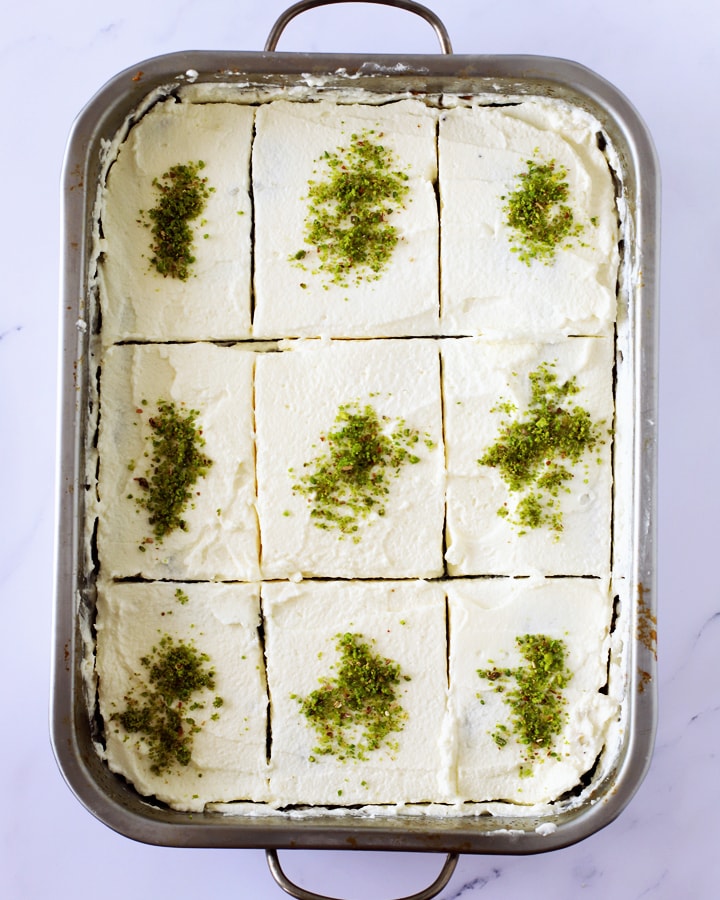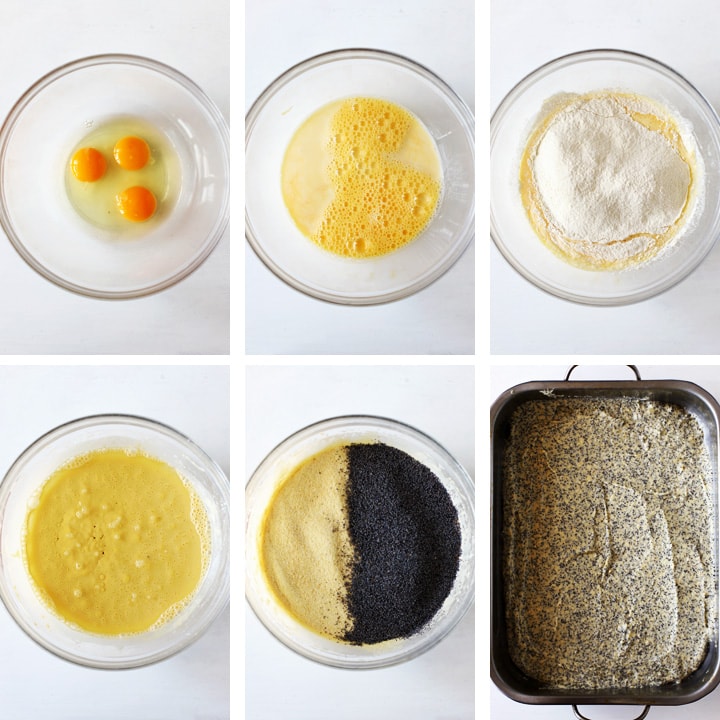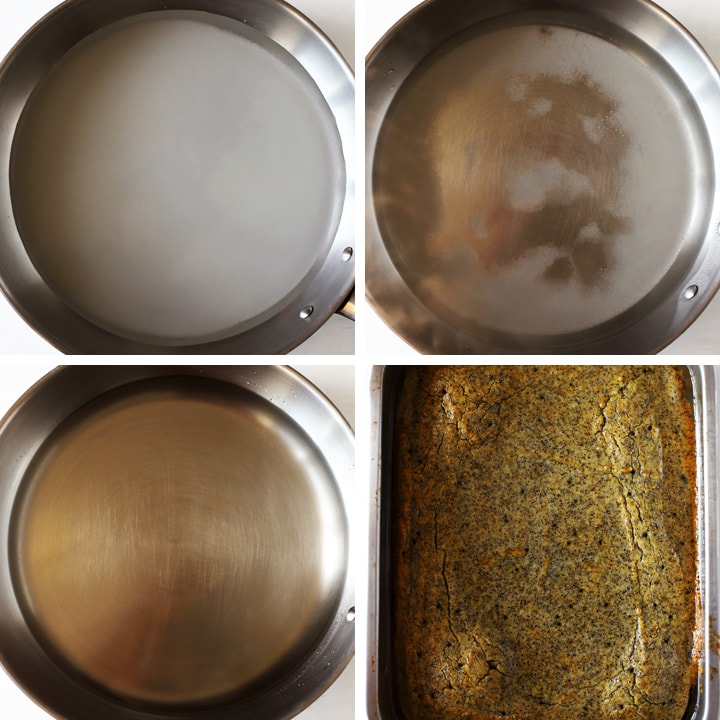Haşhaslı revani is a Turkish poppy seed sheet cake that will capture your heart. It’s a sweet and moist semolina cake full of crunchy poppy seeds and covered in luscious whipped cream. Revani is dense and rich and definitely not for the ones who count calories. It’s sweet, decadent and the best possible way to treat yourself. Put the kettle on because a slice of revani pairs perfectly with a cup of çay (black tea).
Be patient, serve it cold
The first time I had revani was at a friend’s house in Turkey. She had just taken it out of the oven and I watched her pour the hot syrup on it. We ate it straight away and I already thought it was amazing. But when you wait for the cake to soak up all the flavors from the syrup and get all moist and delicious, when you cover it with whipped cream and serve it fridge-cold, revani is really out of this world.
This revani recipe is from my Turkish in-laws, so you can’t get more authentic than that. Actually, you can because I find their revani a tad too sweet. They add a bit more sugar to the cake batter (¾ cup more to be precise), which I find unnecessary because of all the syrup. If you’re used to overly sweet Turkish desserts and that’s what you’re looking for, add that extra ¾ cup of sugar when you beat the eggs together. I seriously think it’s sweet enough without it but maybe it’s my Frenchness talking.
Cook the syrup gently and you’ll be good to go
Pouring syrup is always my favorite part of a Turkish dessert recipe. I love the way it sizzles on hot bakes and the way it gets absorbed little by little. Sure it means you need to be a bit patient before digging in but seriously it is so worth it. I was so unsure the first time I made revani because I had never poured any liquid on a cake before. However, if you’ve made a poke cake before you’ll be in familiar territory because the same principles apply.
Pouring a sugar-water syrup on a dessert is so common in Turkey, it’s the base for many recipes (lokma, baklava, künefe,…). As soon as you’ll get the hang of making syrup it’ll open up new delicious baking horizons. And by ‘get the hang’ I mean making it once because that’s all it takes to master it. As long as you avoid non-stick pans and stirring the sugar too much, it shouldn’t crystallize. Keep your sugar over medium heat and let it melt slowly without too much disturbance.

Şerbetli tatlı (dessert with syrup)
My in-laws keep a little notebook in a kitchen drawer full of the ‘recipes’ they get from their loved ones. I put recipes in air quotes because in true Turkish fashion there are no full-length detailed recipes. They are mostly vague lists of ingredients with (sometimes) a few words for steps. Even this could be perceived as a lot of information since recipes are mostly passed down orally. In this little notebook of theirs, this recipe is titled Haşhaşlı Kek (Cake with poppy seeds) but it’s basically a revani with poppy seeds added to the batter. Classic revani isn’t usually covered in anything. Maybe a sprinkle of ground pistachio or shredded coconut is added on top but that’s it. On the other hand, poppy seeds revani are more often than not covered with whipped cream. Don’t ask me why but it sure tastes great and I’m not complaining.
Turkish desserts are usually divided in 2 categories; syrup-based desserts (şerbetli tatlılar) and milky/custardy puddings (sütlü tatlılar). Revani is a staple of Turkish desserts that are drenched in sweet syrup. It’s more common without the poppy seeds but I love the crunchiness they bring, not to mention the rich whipped cream on top. You’re not eating a boring old semolina cake with this version of revani.
Irmik or Turkish semolina
Irmik is made from durum wheat and is coarser than all-purpose flour. It’s a very common ingredient in Turkey where it’s mostly used for desserts. If you can’t get your hands on irmik in a Turkish store, feel free to replace it with semolina flour. You can find semolina flour in most major supermarkets in the baking aisle next to the different kinds of flour or in the ‘world food’ aisle. Semolina flour is mostly marketed as an Italian ingredient used for pasta or pizza doughs. It might be labeled as semola, semolina or pasta flour. Whatever you find, make sure the semolina flour is made with durum wheat and you’ll be good to go.

Are you looking for other Turkish dessert recipes? Here are some of my favorites:
- Portakallı kurabiye (orange cookies)
- Irmik helvası (no-bake semolina cakes)
- Kayısı atomu (apricot balls)
Revani
- Prep Time: 40 minutes
- resting: 4 hours
- Cook Time: 35 minutes
- Total Time: 5 hours 15 minutes
- Yield: 9 slices 1x
- Category: Dessert
- Method: Baking
- Cuisine: Turkish
Description
Revani is a semolina cake so sweet and moist that it’ll capture your heart. This version of revani is full of crunchy poppy seeds and covered in luscious whipped cream.
Ingredients
For the cake:
- 3 large eggs
- 200ml milk (¾ cup + 1 tbsp)
- 50g caster sugar (¼ cup)
- 175g flour (1 ¼ cup)
- 8g baking powder (2 tsp)
- 215ml vegetable oil (1 cup)
- 175g irmik (1 cup)
- 100g poppy seeds (¾ cup)
For the syrup:
- 300g caster sugar (1 ½ cup)
- 300ml water (1 ¼ cup)
- 1 tsp lemon juice
For the topping:
- 300ml whipping cream, fridge-cold (1 ¼ cup)
- 55g powdered sugar (⅓ cup)
- 1 tsp vanilla extract
- 2 tbsp shelled crushed pistachios or poppy seeds (optional)
Instructions
- Prepare. Preheat the oven to 180°C (355°F)*. Grease a 5cm-deep (2-inch deep) rectangle baking pan measuring roughly 23*30 cm (9*11 in). You could also use a square pan of a similar size.
- Make the cake batter. Whisk the eggs and sugar in a large mixing bowl for 2 min. Whisk in the milk. Sift the flour and baking powder above the bowl and mix until well combined. Add the oil and mix again. Lastly, add the irmik and poppy seeds and mix until well combined. Pour the batter into the prepared pan, smooth the top with a spatula and bake in the oven for 25 min.

- Make the syrup while the cake bakes. Put the sugar in a large heavy-bottomed saucepan and shake the pan lightly to level the sugar. Pour the water and lemon juice over the sugar and set the pan over medium heat. Once the sugar has mostly liquefied and begins to simmer, stir just a few times with a wooden spoon to dissolve the remaining dry parts and lower the heat. Once the sugar has completely melted, remove the pan from the heat.

- Finish off the cake. Check if the cake is done by inserting a wooden toothpick in its thickest part. It should come out clean. Set the baking pan on a cooling rack. Poke 2 dozens holes all over the cake. I use the probe of my instant-read thermometer to do so. Pour the syrup all over the cake and cover the pan with a dishtowel (make sure it doesn’t touch the cake). Let the cake soak up all the syrup and rest for 1 to 2 hours until the pan is at room temperature.
- Make the whipped cream. Place the whisk and the mixing bowl in which you will whip the cream for 15 min in the freezer. Take out the whisk and bowl from the freezer and the cream from the fridge. Whip the cream with a hand mixer on medium speed until you reach the soft peaks stage. Add the extract and sugar. Increase the speed and mix until everything is incorporated and the cream is really thick. Lift up the beaters of your hand mixer, the peaks should be stiff and stand straight up.
- Add the toppings. Using a palette knife evenly spread the whipped cream on the revani. Chill the revani in the refrigerator for 3 hours minimum, but the longer the better. Divide into pieces and sprinkle extra crushed pistachios or poppy seeds on top if desired.
Notes
* If you use a convection oven preheat the oven to 160°C (320°F).
You can keep revani in the fridge for up to 3 days.
Nutrition
- Serving Size: 1
- Calories: 713
- Fat: 42.7g
Keywords: semolina cake, syrupy desserts, cold cakes


Sumeyra
Hello 👋
Your recipes are all great. But about syrupy deserts, there’s one trick about adding syrup. Either cake should be hot and syrup cold; or syrup hot cake cold. It is more important with baklavas but I think helps with revani too.
Keep up the great work,
Thanks
Amélie
Hi! Thank you so much for your comment and the rec’! I was wondering about the syrup, do you mean fridge-cold or room-temperature-cold? 🙂
Vicky Stylianou
Room-temp is fine: it’s a rule that we follow too; cold with hot, hot with cold! It’s to make sure that it doesn’t turn to mush. Thanks for such a lovely recipe, I’m going to try it today 🌺
Amélie
Thanks for sharing, I hope you liked it!